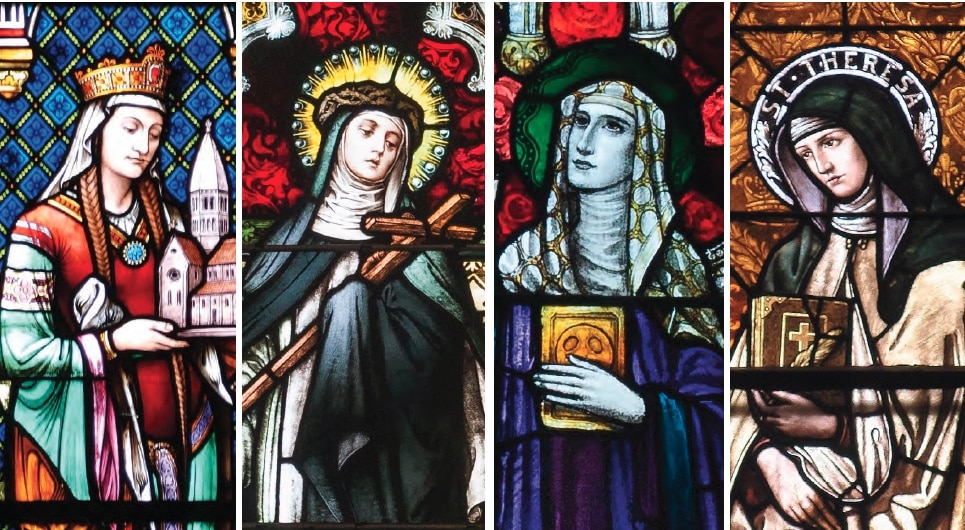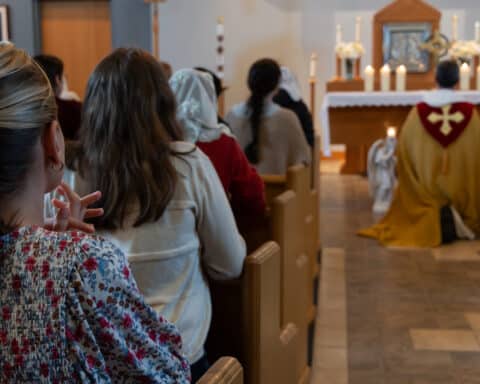As Catholics, we are incredibly blessed to have the Communion of Saints, and each and every one of us is encouraged by the Church to find a patron (or many) from among their number. I know from experience how helpful it is to have someone to journey with along the way, someone whose life offers advice and encouragement, whose wisdom can help guide me, and whose intercession I can turn to in times of struggle.
In my own life, I have found that sometimes I find a saint because I go hunting for them — I have a specific question or need I am hoping to find intercession for. Other times, a saint has found me, bringing with her wisdom I didn’t know I needed. To make it easier for people to find just the right saint to suit their needs, the Church has designated saints as patrons of countries, cultures, occupations, interests and even illnesses.
In addition to this, the Church has created categories of saints, groups of saints with similar qualities. Some are self-explanatory — virgins and martyrs need little description — but others take a little more explanation. The Early Church Fathers, for example, are a precise and small group. One of the lesser known categories, but one of great importance, is that of Doctor of the Church.
Not a medical doctor, this title is meant to convey something like the gravitas of a Ph.D. Though that may sound intimidating or lofty, I’d argue that the Doctors of the Church are just the saints that many of us need to understand the faith better, and more than that, to grow in our relationship with the Lord. I know I have learned much from them over the years, and not just in the academic sense of the word.
What does it mean to be a Doctor of the Church?
Although the saints who receive this designation are not better or more important than other saints (as St. Paul says, there are different kinds of spiritual gifts but the same Spirit), this title honors these men and women for accomplishing something huge: impacting the Church’s theology and with it her people’s understanding of who God is and how they relate to him.
That is incredible! Doctors of the Church articulated doctrine and dogma in a way that made sense, that clarified and conceptualized very large and often abstract ideas into ways that everyday people could understand. It wasn’t until reading St. Teresa of Ávila’s “Interior Castle” that I was able to comprehend the ways that God was working in my soul, and it was through St. Thérèse’s “Story of a Soul” that I was able to grow in understanding of his radical mercy.
The criteria to be a Doctor of the Church
To be declared a Doctor of the Church, a person must meet three criteria:
- The person must be of exemplary holiness.
- They must have contributed substantially to the Church’s theology and moral life through their writing, research or speaking.
- They must be declared a Doctor by either a full Church council or by papal decree.
While all canonized saints lived lives of exemplary holiness — that’s part of what it means to be a saint — in the process of being considered for the title of Doctor of the Church, a saint’s life is scrutinized again just to be sure.
The second criterion is more complicated and precise. To be considered for the title Doctor of the Church, it must be proven that a saint’s contributions are both orthodox and unique — that they provide fresh insights into Catholic teaching and doctrine that are both applicable and needed in their own time period and also timeless, remaining true and helpful to Catholics of future generations. This tells me as a lay person that every saint bearing the title of Doctor of the Church has something to say to me, a member of God’s Church, today, in the here and now.
The first Doctors of the Church were designated by Pope Boniface VIII in the 13th century. Since then popes throughout the centuries have added more saints to their number. Today we have 37 Doctors of the Church. Some are very well-known saints, like Jerome and Augustine, and others are more obscure, likely to be only known in Catholic academic circles.
Nestled among these 37 great saints are four women Doctors of the Church, the only women in Church history to rise to this distinction.
Who are these women?
It wasn’t until 1970 that the first women were declared Doctors of the Church. The honor went to St. Catherine of Siena and St. Teresa of Ávila, who, within a week of one another, were added to the list by Pope Paul VI.
In 1997, Pope John Paul II bestowed the title on St. Thérèse of Lisieux on the centenary of her death. And finally, to round out the four, Pope Benedict XVI declared St. Hildegard of Bingen a Doctor of the Church in 2012.
It’s not possible to give a full account of their lives in the span of a single article. Each woman has been the subject of countless biographies and much research. But I hope that providing a brief sketch of their life and accomplishments will encourage you to read one of those biographies or, even better, their actual writings.
St. Hildegard of Bingen
St. Hildegard of Bingen was born to a noble family in the year 1098. Even as a child, she had mystical visions of the Lord, though it wasn’t until she was older that she was able to understand the meaning of them all. As a young woman, she entered religious life, and it was here that her talents truly exploded. St. Hildegard was a woman who did everything and did it well.
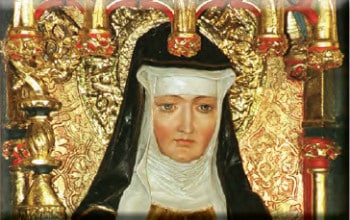
At age 43, she sought the advice of her spiritual director about her visions, and their authenticity was declared by a committee of Church theologians. This led her to write them and their meanings down into her great mystical work, “The Scivias.” It also allowed her to seek and receive permission from the pope to travel and evangelize, making her one of the only women of her time to be allowed to preach publicly. An enduring theme in St. Hildegard’s theology is the ability to find God through the use of our senses.
In addition, the prolific Hildegard wrote the first known morality play, lyrical poetry, a cookbook, medical treatises (she was also the equivalent of a medical doctor in her time), and even came up with her own language. She also composed beautiful music, which is played by orchestras around the world to this day.
St. Hildegard died in 1179. She was canonized in 2012 by Pope Benedict XVI and declared a Doctor of the Church the same year.
St. Catherine of Siena
St. Catherine of Siena was born in 1347 to a well-respected family. She was the youngest of 25 children, though most of her siblings did not survive to adulthood. Catherine consecrated herself to Christ while young and refused to marry, even cutting off her hair to disrupt a proposal.
She obtained reluctant permission from her parents to renew her vow of virginity and enter the third-order Dominicans, which would allow her to remain living with her family.
Catherine’s impact on the Church

For many years St. Catherine lived as a hermit in her family’s home but eventually began venturing out, and her ministry extended across the oceans. She traveled extensively at the behest of both popes and civic leaders, playing an active role in the Church and Italian politics, both very complicated during her lifetime. St. Catherine was clearheaded about the sins and failures of the leaders of the Church, but obedience to the Lord and the Church were uppermost in importance to her. She always worked to draw more and more people to Christ her bridegroom, even as she worked to bring peace amongst warring parties. In fact, St. Catherine is credited with ending the Avignon Papacy and returning the Pope to Rome.
She wrote voluminously, mostly in letter form, offering blunt but loving advice to her spiritual children as well as the bishops and cardinals who sought her out for her wisdom. Almost four hundred of her letters survive today.
While in a state of ecstasy, St. Catherine dictated a series of conversations she had with the Lord, which were later published under the title “The Dialogue.” Intimately personal, and yet full of instruction that is applicable to all, this piece seamlessly weaves theology and personal prayer together. St. Catherine’s prayer life was deep and full of the mystical, and she received the stigmata from the Lord at the age of 28.
St. Catherine died a young woman, just 33 years old. She was canonized in 1461.
St. Teresa of Ávila
The woman we know today as St. Teresa of Ávila was born Teresa Sanchez de Cepeda y Ahumada on March 28, 1515. Born into a family of Spanish nobility, Teresa learned about faith and honor at her mother’s knee. The lives of the saints, read to all the children in their family, were influential in her childhood, even to the point that she and her brother Rodrigo ran away from home, vowing to become martyrs.
At age 20, Teresa entered the local Carmelite convent. This particular convent was known for being lax in its practices, and as a result, the extroverted and popular Teresa spent a great deal of time socializing in the parlor with visitors. Indeed, for years she struggled greatly, torn between the worldly and the divine.
St. Teresa’s conversion
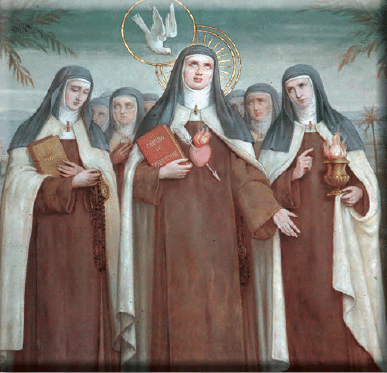
It wasn’t until she reached the age of 40 that she had a full conversion and conviction that God was asking more of her. It was this deep spiritual awakening within herself that began what would turn out to be the great restoration of the Carmelite order as a whole and the founding of the Discalced Carmelites. Teresa’s attempts to restore the order to its original austerity were met with great resistance both within and without, but even so, she still managed to found and nurture 16 new convents.
In addition to this great work, Teresa wrote extensively, primarily to the sisters that she lived with and mentored, to help them to reach greater intimacy with God. Her most well-known piece is “The Interior Castle,” which follows the path that a soul takes on its journey to Christ. Though it touches on great theological truths at length, it is also remarkably readable for the average person and contains a great deal of the author’s personality, rendering it very relatable and engaging.
Teresa of Ávila died at age 67 in 1582. She was canonized a mere 40 years after her death in 1622 by Pope Gregory XV.
St. Thérèse of Lisieux
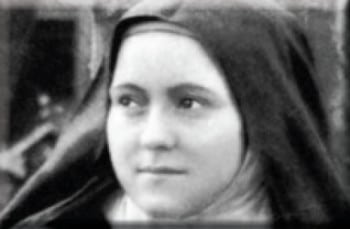
St. Thérèse of Lisieux was born the youngest of nine children (five who survived childhood) to Sts. Louis and Zelie Martin and was, by all accounts, a deeply beloved addition to the family. After her mother’s death at age four, Thérèse was raised by her father and older sisters.
She knew that God was calling her to religious life at a very young age and was so determined to follow several of her older sisters and enter the Carmelite order that, during a papal audience while on a pilgrimage to Rome with her father, she asked the pope to grant her special permission to profess her vows early. Undeterred by his no, she entered Carmel at the young age of 15 and never looked back.
Thérèse struggled with scrupulosity and depression, but through it all she maintained a deep and childlike faith in the Father’s love for her that would become the cornerstone of her great theological work. Under the order of her prioress, Thérèse wrote down her doctrine of faith, “Story of a Soul.” It is this book, which preaches holiness through the ordinary combined with a fearless faith that is total in trust and surrender to God, that would later lead her to become the youngest of all of the Doctors of the Church.
Thérèse died at the tender age of 24 of tuberculosis. She was canonized in 1925.
Why so few female Doctors?
While it is clear that not every saint fits the requirements for Doctor of the Church, the small number of women on the list makes it obvious that women are underrepresented. That means that either women are not inherently capable of rising to the required level, and thus the four who did are anomalies, or that there are more worthy women whose contributions have been overlooked by the Church. Personally, I think it’s the latter, especially when considering the criteria, the historical bias of the Curia, and reflecting on the lives and works of other great female saints.
Exemplary holiness
First, the title requires exemplary holiness. Now, one could argue that each saint has already reached those heights, but consider the fact that with regard to female saints, what it meant to be holy was very narrow for a long portion of Church history. For centuries, there were two ways to be considered a holy woman: to be a cloistered (and quiet) religious sister or to quietly busy yourself with the duties of home and hearth.
The women who didn’t fit this model were often scorned and even investigated by the Church during their lifetimes. Even in later generations, most men were not ready to hold up these groundbreaking and paradigm-shifting women as models of holiness. Pope St. John Paul II’s concept of the feminine genius is a relatively new theological construct. The same is true of women taking positions of leadership within the Church (and in society at large).
Teresa, Catherine and Hildegard were hardly the model of ideal femininity during their lifetimes given their marked assertiveness (among other qualities), or even in the generations that followed. Thérèse was viewed as meek and humble, but as an uneducated young woman, she was overlooked as a theologian.
Contributions to theology
This brings us to the second requirement, that the saint has contributed to Church theology and has helped the Church as a whole to have a deeper understanding of the Faith through their writing and speaking. Again, it’s not surprising for it to have taken so long for women to be recognized. Remember, for centuries many women were not taught to read and write, so the writing requirement removes most of them from contention. And, not every woman would have had the resources that St. Catherine had with the ability to dictate letters to secretaries. Would more have contributed to the Church’s theology if given the chance? Unfortunately, we’ll never know.
Even women who could read and write were not often treated as intellectual equals by the men who ran the Church. Looking at the types of writing by the four women Doctors of the Church, there is a difference from that of many of the male Doctors. Though just as sound in doctrine and dogma, the writings of Hildegard, Catherine, Teresa and Thérèse are more relational and conversational than those of their male counterparts. Interestingly, the four women Doctors were most often writing for an audience of women as well, perhaps another reason that they were overlooked as containing wisdom that the entire Church would benefit from.
Papal decree
It wasn’t a foregone conclusion that the title of Doctor of the Church would ever be held by a woman, regardless of her qualifications in the first two categories. In fact, in his apostolic letter explaining the decision to declare St. Teresa of Ávila a Doctor of the Church, and after expounding on her vast contributions to theology, Pope Paul VI noted that he asked the bishops convened in the Ordinary Assembly to study the idea that a woman might be allowed to hold the title before bestowing it on her. This was in 1967. Before this, it hadn’t even been considered an option within the Church hierarchy.
Are there other women who fit this category?
In my humble opinion, there are undoubtedly other women who deserve to have this title bestowed upon them. And I am not the only one to think so.
In 2015, the Marian Helpers put together a well-reasoned and thoroughly researched petition to the Holy See arguing that St. Faustina ought to be admitted to the group. Through her visions and writings, the Church has come to a deeper understanding of Christ’s merciful love, and her insights into the Divine Mercy of Our Lord have changed the face of the Church. Writing just before the outbreak of World War II, it is undeniable that St. Faustina’s message was urgent in her time period, and no one who has attended Mass the Sunday after Easter, now known the world over as Divine Mercy Sunday, can argue with the world-wide and enduring nature of her message.
The Carmelites have also begun a petition on behalf of St. Edith Stein, a woman who actually did hold a Ph.D. Her doctoral dissertation was on the subject of empathy, a topic that she would return to in later writings after her conversion to Catholicism. Within her 28 volumes of writings, there is ample theological insight of value to the entirety of the Church.
And who could argue that the writings of St. Margaret Mary Alacoque have not influenced the entirety of the Church? Her name might be less familiar to many than other saints, but the devotion to the Sacred Heart, which we owe to her, is not.
These are only three examples. There are more women to be found within our Church’s history and, I am sure, more women Doctors of the Church to come in the future.
Why does it matter if there are only four?
Some people might ask why does it matter that there are only four women Doctors of the Church? To this, I would respond that it matters a great deal.
It matters because women have a different voice than men and different experiences of God that deserve to be heard not just by women, but by all of us. Pope Saint John Paul II wasn’t wrong when he wrote about the feminine genius — women shape our Catholic Church every single day in ways both big and small.
Having more women honored with this title matters because the truth is that more than four women have substantially contributed to our Church’s theology over the past two millennia, and we proudly own and proclaim that truth.
As a mom of young daughters, it matters because my girls need role models — women who were faithful and barrier breakers at the same time, women of strength and intelligence, of courage and wisdom. It matters because my girls are equal members of the future of the Catholic Church and they deserve to be able to see what is possible.
Colleen Pressprich is the author of “The Women Doctors of the Church” (OSV, $16.95). She writes from Michigan.

